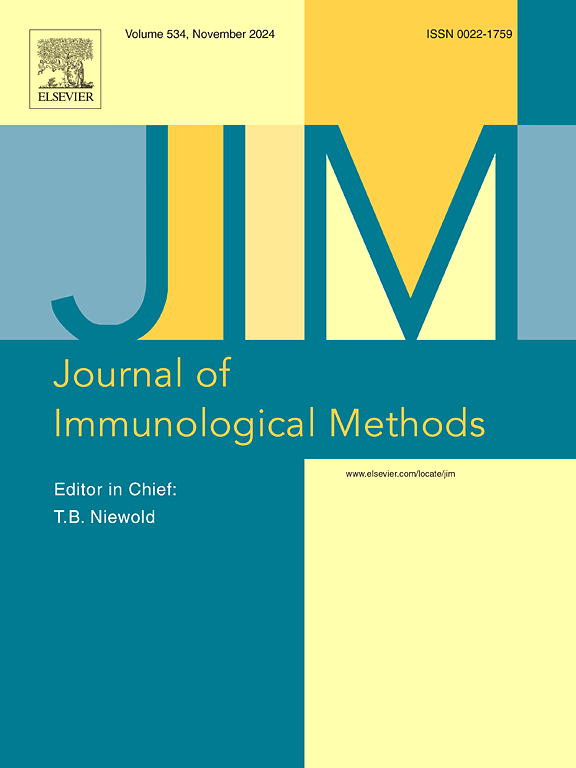犬细小病毒VP2结构蛋白单克隆抗体的制备及特异性鉴定
IF 1.6
4区 医学
Q4 BIOCHEMICAL RESEARCH METHODS
引用次数: 0
摘要
犬细小病毒(MVC)属于Bocaparvovirus属,在全世界的新生犬中引起严重的呼吸道和胃肠道症状。结构蛋白VP2对MVC的附着、感染、脱包和诱导宿主免疫应答至关重要。本研究旨在利用杂交瘤技术制备抗VP2的单克隆抗体(mAb)。AlphaFold和CavityPlus的生物信息学分析显示,VP2的n端区域(氨基酸1-300)具有结构特征,使其成为产生有效抗体的最合适靶点。成功构建了融合Trx和His标签的重组质粒pET-32a(+)-VP2(N300)。免疫小鼠后获得9株杂交瘤细胞株,分别为1G5、1G5 - 1、1I24、1I24 - 1、2E6-1、2株N9、3C12-1、4株M1、4株M1 - 1。所有细胞系腹水抗体滴度均在1:10万以上。对感染MVC的Walter Reed犬细胞进行Western blot分析,筛选出特异性较强的3株单克隆抗体:1G5、3C12-1和4m1。这3株菌株可用于免疫荧光(IF)和免疫沉淀(IP)检测VP2蛋白。本研究制备的单克隆抗体mAb VP2可作为一种有价值的检测MVC的工具,有助于研究MVC感染的机制。本文章由计算机程序翻译,如有差异,请以英文原文为准。
Preparation and specific identification of monoclonal antibodies targeting the VP2 structural protein of minute virus of canines
The Minute Virus of Canines (MVC), classified under the genus Bocaparvovirus, causes severe respiratory and gastrointestinal symptoms in neonatal canines worldwide. The structural protein VP2 is essential for the attachment, infection, uncoating, and induction of the host immunological response to MVC. This study aimed to prepare a monoclonal antibody (mAb) against VP2 using the hybridoma technique. AlphaFold and CavityPlus bioinformatics analysis revealed that the N-terminal region of VP2 (amino acids 1–300) possesses structural characteristics that make it the most suitable target for effective antibody generation. The recombinant plasmid pET-32a(+)-VP2(N300) with fused Trx and His tags was successfully constructed. After immunizing mice, nine hybridoma cell lines were obtained, namely 1G5, 1G5–1, 1I24, 1I24–1, 2E6–1, 2 N9, 3C12–1, 4 M1, and 4 M1–1. The ascitic antibody titers of all cell lines were above 1:100,000. Western blot analysis of Walter Reed canine cells infected with MVC indicated the selection of three strains of monoclonal antibodies with strong specificity: 1G5, 3C12–1, and 4 M1. These three strains can be employed in immunofluorescence (IF) and immunoprecipitation (IP) tests for detecting VP2 protein. The monoclonal antibody mAb VP2 prepared in this study may serve as a valuable tool for detecting MVC and beneficial for investigating the mechanisms of MVC infection.
求助全文
通过发布文献求助,成功后即可免费获取论文全文。
去求助
来源期刊
CiteScore
4.10
自引率
0.00%
发文量
120
审稿时长
3 months
期刊介绍:
The Journal of Immunological Methods is devoted to covering techniques for: (1) Quantitating and detecting antibodies and/or antigens. (2) Purifying immunoglobulins, lymphokines and other molecules of the immune system. (3) Isolating antigens and other substances important in immunological processes. (4) Labelling antigens and antibodies. (5) Localizing antigens and/or antibodies in tissues and cells. (6) Detecting, and fractionating immunocompetent cells. (7) Assaying for cellular immunity. (8) Documenting cell-cell interactions. (9) Initiating immunity and unresponsiveness. (10) Transplanting tissues. (11) Studying items closely related to immunity such as complement, reticuloendothelial system and others. (12) Molecular techniques for studying immune cells and their receptors. (13) Imaging of the immune system. (14) Methods for production or their fragments in eukaryotic and prokaryotic cells.
In addition the journal will publish articles on novel methods for analysing the organization, structure and expression of genes for immunologically important molecules such as immunoglobulins, T cell receptors and accessory molecules involved in antigen recognition, processing and presentation. Submitted full length manuscripts should describe new methods of broad applicability to immunology and not simply the application of an established method to a particular substance - although papers describing such applications may be considered for publication as a short Technical Note. Review articles will also be published by the Journal of Immunological Methods. In general these manuscripts are by solicitation however anyone interested in submitting a review can contact the Reviews Editor and provide an outline of the proposed review.

 求助内容:
求助内容: 应助结果提醒方式:
应助结果提醒方式:


